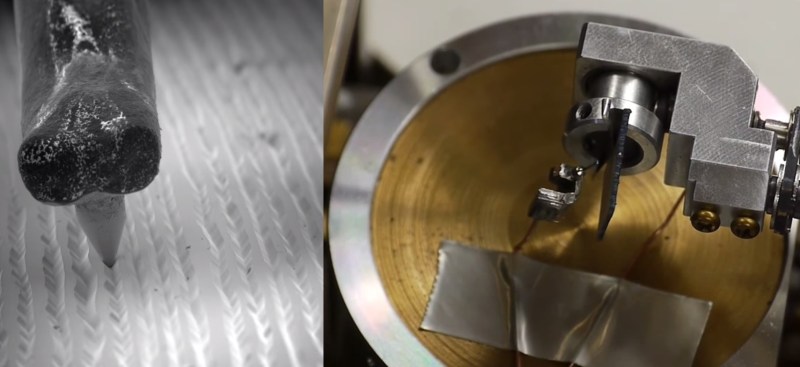Hackaday Prize judge [Ben Krasnow] has been busy lately. He’s put his scanning electron microscope (SEM) to work creating an animation of a phonograph needle playing a record. (YouTube link) This is the same 80’s SEM [Ben] hacked back in November. Unfortunately, [Ben’s] JSM-T200 isn’t quite large enough to hold an entire 12″ LP, so he had to cut a small section of a record out. The vinyl mods weren’t done there though. SEMs need a conductive surface for imaging . Vinyl is an insulator. [Ben] dealt with this by using his vacuum chamber to evaporate a thin layer of silver on the vinyl.
. Vinyl is an insulator. [Ben] dealt with this by using his vacuum chamber to evaporate a thin layer of silver on the vinyl.
Just imaging the record wouldn’t be enough; [Ben] wanted an animation of a needle traveling through the record grove. He tore apart an old phonograph needle and installed it in on a copper wire in the SEM. Thanks to the dual stage setup of the JSM-T200, [Ben] was able to move the record-chip and needle independently. He could then move the record underneath the needle as if it were actually playing. [Ben] used his oscilloscope to record 60 frames, each spaced 50 microns apart. He used octave to process the data, and wound up with the awesome GIF animation you see on the left.
 [Ben] wasn’t done though. He checked out a few other recording formats, including CD and DVD optical media, and capacitance electronic disc, an obscure format from RCA which failed miserably in the market. The toughest challenge [Ben] faced was imaging the CD media. The familiar pits of a CD are stored on a thin aluminum layer sandwiched between the lacquer label and the plastic disc. He tried dissolving the plastic with chemicals, but enough plastic was left behind to distort the image. The solution turned out to be double-sided tape. Sticking some tape down on the CD and peeling it off cleanly removed the aluminum, and provided a sturdy substrate with which to mount the sample in the SEM.
[Ben] wasn’t done though. He checked out a few other recording formats, including CD and DVD optical media, and capacitance electronic disc, an obscure format from RCA which failed miserably in the market. The toughest challenge [Ben] faced was imaging the CD media. The familiar pits of a CD are stored on a thin aluminum layer sandwiched between the lacquer label and the plastic disc. He tried dissolving the plastic with chemicals, but enough plastic was left behind to distort the image. The solution turned out to be double-sided tape. Sticking some tape down on the CD and peeling it off cleanly removed the aluminum, and provided a sturdy substrate with which to mount the sample in the SEM.
We’re curious if stereo audio data can be extracted from the SEM images. [Oona] managed to do this with a mono recording from a toy robot. Who’s going to be the first one to break out the image analysis software and capture some audio from [Ben’s] images?
















Fantastic!
Woaaaaaaaaaaaaaa this looks great. Thanks Ben!
Surely to get any audio data from the CD we’d need a lot more of the CD to have been scanned.
…and proper use of the green marker, too!
lol
Why not use a 7″ rather than chop a 12″ up.
However, the result is awesome!
Can think of two likely reasons:
1) I doubt even a 7″ would fit intact. On an SEM, the specimen is placed in a chamber that must be sealed. Then most of the air is removed using a traditional vacuum pump. At some point the remaining gas molecules become so rarified they can’t be sucked out, you simply have to wait for them to bounce out of the chamber on their own; typically into a turbomolecular pump, that works by catching them in oil to prevent them from bouncing back in. This takes a while. If you have a large chamber this takes longer. And more quickly saturates the oil with gas molecules, eventually it becomes so loaded with them that they escape faster than they’re caught, at which point you must replace the oil (which I assume isn’t cheap). So the chamber on a typical SEM is small.
2) [Ben] was moving the needle through the groove *manually*, using the SEM stage controls. Easier to accomplish on a groove with less curvature, like you find on the outer edge of a 12″. Plus since a record rotates at constant RPM, information is less tightly packed on the larger diameter grooves, which also makes it easier to manually follow.
Ok, time for a lesson on vacuum pumps and the way a couple types function. you have mixed into one pump two different technologies and there is a small amount of misinformation that makes your description wrong. First yes a conventional mechanical vacuum pump (can be a screw type or piston design) and it does remove the bulk of the air in the chamber, hence this pump is sometimes called a roughing pump as it roughs down the chamber. To get a better vacuum (lower pressure) a different method is required to pump the chamber into the high vacuum range. The mention of a turbo molecular pump is a secondary type that can be used, however it contains no oil or fluid as a pumping mechanism the turbo pump is what it sounds like a turbine that has hundreds if not thousands of blades arranged on a central shaft, the blades are very small at the top of the pump and increase in size at each successive level of the shaft. turbo pumps have low friction bearings, often magnetic and frictionless (no physical contact points) the shaft spins at very high speeds often 100,000 or more RPM. The turbo’s effect is to increase the density of air exiting the chamber and the lower end of the turbo is connected to the roughing pump which has been switched via a valve system from direct connection to the chamber to now the “high” pressure end of the turbo where the air is now at a density allowing the mechanical pump to effectively work and remove the air causing the chamber to reach better and better vacuum (lower concentration of molecules in the chamber). there is no limit to the length of time the turbo can maintain the chamber pressure. The only limiting factors are the maximum vacuum that a particular size turbo can reach and the contamination of the system with water (hard to pump) or oily substances like finger prints which cause outgassing and make the system not preform at the best it can. Another type of secondary pump is a diffusion pump this type does use a type of specialty oil to move molecules from low concentrations to higher conc. and again the diffusion pump is “backed” by a mechanical pump. The diffusion pump works sort of similar to an old fashion coffee percolator. the oil is heated to a vapor and rises up the chimney or throat of the diffusion pump it is heated electrically at the bottom of the unit, the throat contains baffles space apart in the center of the throat, the pump is cooled with cold water coils starting at a bit above the middle of the throat and increase in number as they approach the top of the diffusion pump. the oil vapor is cooled as it nears the top of the unit and at near the top it becomes dense and heavy enough to fall back to the bottom of the unit. the baffles help condense and cool the vapor this high molecular weight vapor traps air molecules in the falling vapor stream causing again a great enough density of air molecules to build at the bottom of the diffusion pump where the air is removed by yes the mechanical roughing pump, now operating as a “backing” pump. In both turbo and oil diffusion pumps there is at no time a saturation of an media with a excess of air molecules and no need ever exists to replenish or purify the oil as air molecules are moved by the oil but are then further moved by a mechanical pump.
The only thing that can happen to a oil diffusion or even an oil lubricated mechanical pump is contamination of the oil with a material that is not removed by the backing pump often the offending substance is water which condenses as pressures are varied and the system operates at humid conditions. Also with oil diffusion pumps the gate valve to the chamber MUST be closed when the chamber is returned to atmospheric pressure, failure to close the gate valve will let the hot (much above the flash or smoke point of the oil at atmospheric pressure.) be exposed to air and it will instantly burn contaminating the chamber with oily soot and carbonizing the diffusion pump rendering the system unfit for service. It can take weeks to clean and rebuild the system after such an accident.
Sorry if this seem preachy or overly long but my background is in semiconductor reactors and those use high vacuum systems and its just my thing hope I helped and I will be glad to assist anyone with vacuum system issues if they need me. (hey the company I worked for billed 350 an hour plus expenses for me to service a customer!! )
No apologies necessary, that is a fantastic description and thank you for it! I had it explained to me once before by the SEM operator at work more than ten years ago, and my memory was indeed wrong on calling our oil diffusion pump a turbo molecular, and the mechanism by which it removes rarified gas molecules.
awesome
I managed to get a little bit of audio: https://clyp.it/uyto3ogx (obviously jumps around as only a small section of the record was visible…)
Ha!
Oh Noes! Rickrolled!
Oh that’s just wrong man! (Though it would be hilarious if [Ben] actually used that song…)
I knew what I would get into but I must say that it looks quite authentic. Perhaps needs a bit more distortions.
That is amazing… wow! But after hearing that song, I know why he cut the disk up… lol
Apologies all, couldn’t resist ;D
I really missed the background music which would be in sync with the animation…
It’d be hard to get any useful audio from his LP pictures; each cut-out piece is only somewhere around 1/20th of a second long.
I bet you could extract audio from picture of that vinyl alone :)
I always wondered how those capacitive video discs worked, we used to have those and they were so faulty and dust-prone.
https://en.wikipedia.org/wiki/Capacitance_Electronic_Disc
Reminds me of the laser phonograph which replaces the traditional needle with a laser scan that reads the variations in a phonograph record groove and then converts this into an audio signal that can be played. I believe this device has been around for at least 10 years and was marketed to libraries and other users that did not want to wear the grooves in a traditional phono record. As I remember the price was between 25 to 35 thousand dollars then.
University of NC Libraries’ Wilson Library has one. Its big trick is that it can play a record so badly melted it looks like a taco.
Seems like a perfect project for HaD! Wonder why nobody’s tried it yet….
you can scan a record: http://www.cs.huji.ac.il/~springer/DigitalNeedle/index.html
That’s some pretty neat technology, but if that’s what a bad acid trip sounds like, I’d kill myself gleefully to escape that horror. That’s the sounds nightmares are made off.
Also just realized that almost sounds like its playing backwards.
It famously appeared in a George Michael video, but might not have been noticed among all the supermodels.
That animation of the needle on the LP is really something special! Also, I can’t believe how tiny the tracks are on that CED compared to the stylus, it almost looks like it’s astride two tracks.
Small pics, big hack!
The Smithsonian in Washington DC is on it…
http://www.smithsonianmag.com/history/we-had-no-idea-what-alexander-graham-bell-sounded-like-until-now-37585123/?no-ist
That’s awesome.
Getting audio from a CD is harder though because the contents of each block of data are not very contiguous on the disc; they’re spread all over the place using a distributed error correction scheme (part of redbook) so that localised damage (like a scratch) will not cause the signal to drop out. You would need a good angular fraction of the disc to get anything at all, but then you’d get heaps.
OH NO, NO, NO, NO ……..willie Persec called the stylus a NEEDLE ………… a thousand needles stuck in your backside for punishment!